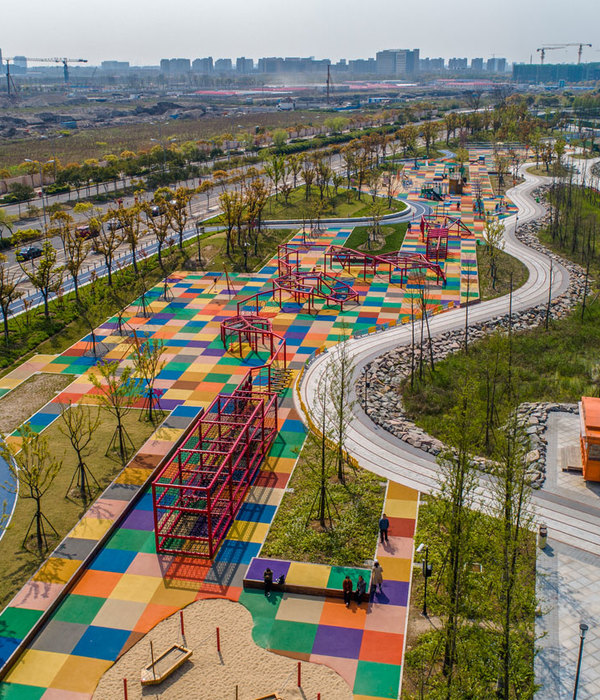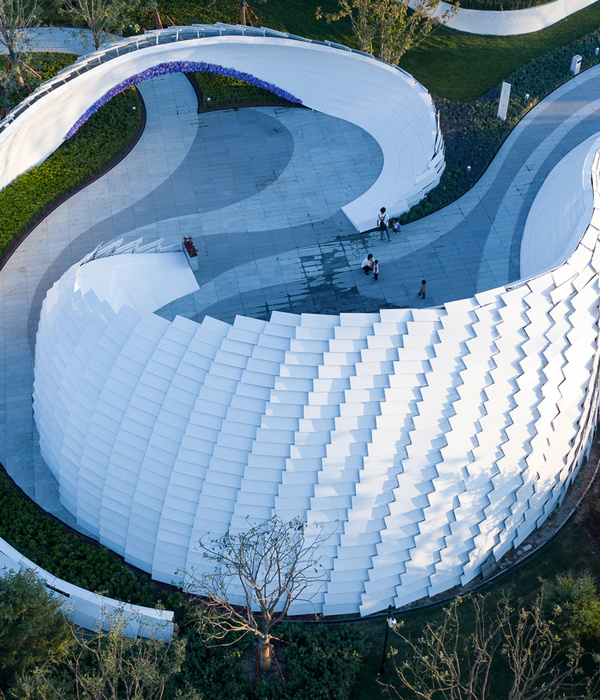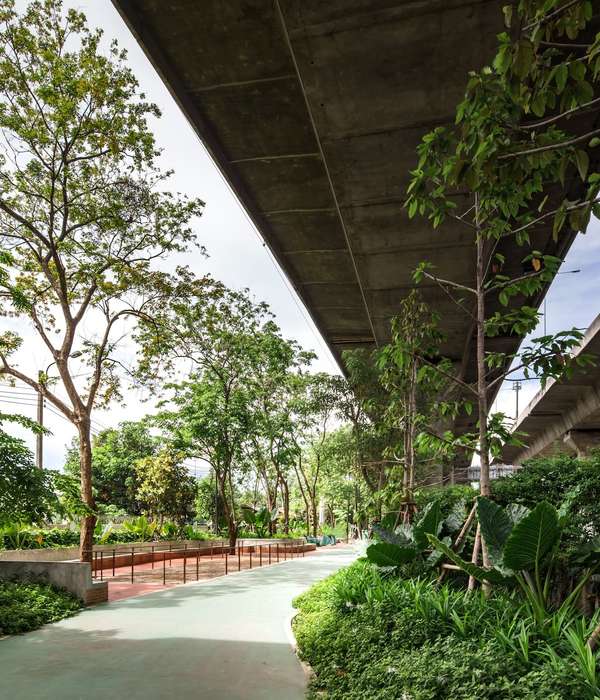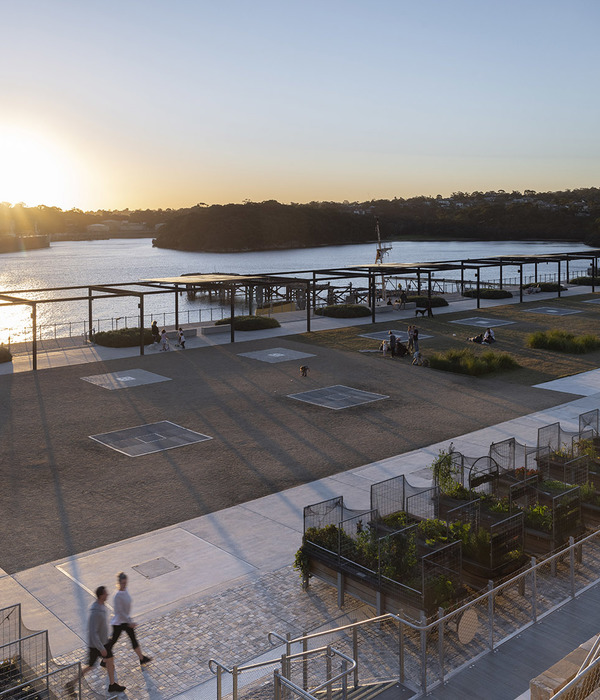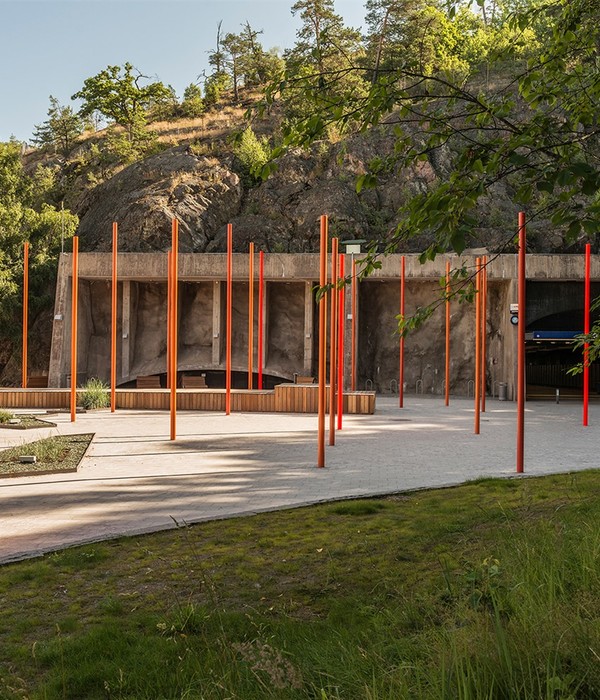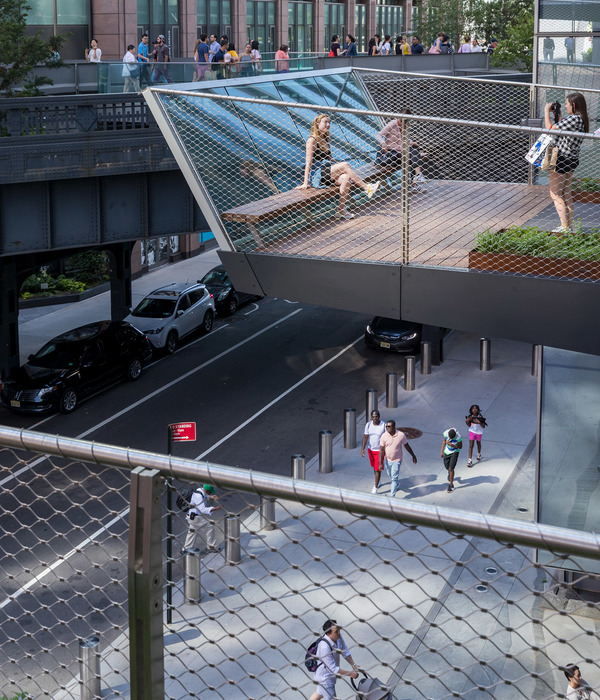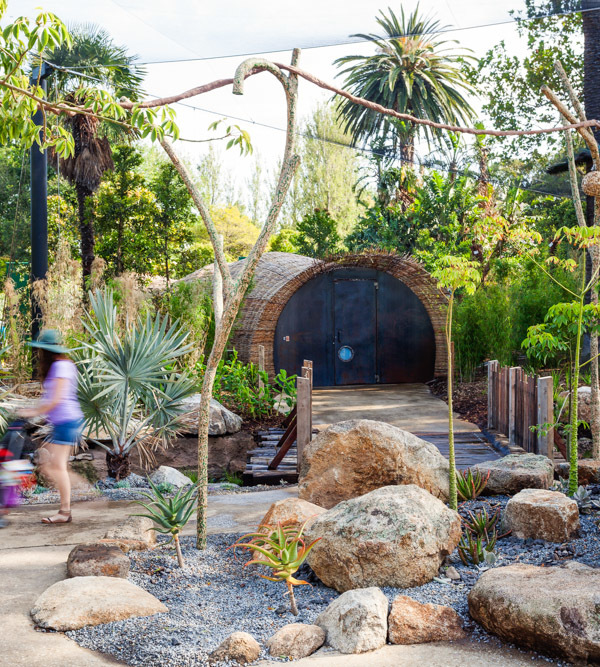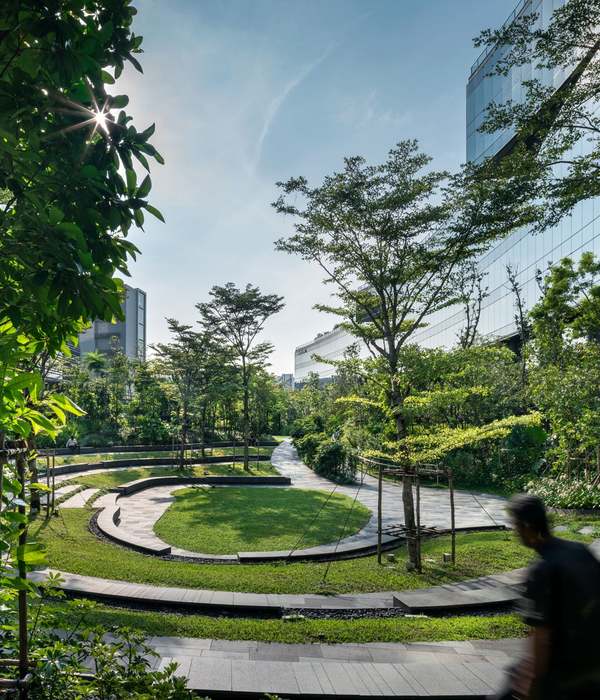*项目名称释意:“TIJ”在荷兰语中是“潮水”的意思,在该项目中指的是哈灵水道的回潮,在读快时还有“蛋”的意思。 ‘T IJ (name explanation: This is a Dutch word joke. ‘TIJ’ means ‘tide’ which refers to the returning tides in the Haringvliet, but quickly pronounced it also means ‘the egg’)
‘T IJ是为庆祝2018年11月哈灵水道的开闸而设计的一系列作品中规模最大且最显著的一个。水闸的开放旨在提高水质并增强生物多样性,同时促使鱼类从荷兰的北海迁移至马斯和莱茵河的三角洲地带。该举措将创建一个耐盐及喜盐的新环境,周边自然保护区的生物多样性也将逐渐增加,在未来几年形成一个更加强健的生态系统。为了鼓励人们亲自体验并探索这些变化,哈灵水道地区新建了一系列鸟类观测站。
‘T IJ is the biggest and most striking of a series of objects designed to celebrate the opening of the Haringvliet sluices in November 2018. The sluices were opened in order to improve water quality and biodiversity, while also stimulating fish migration from the North Sea to the river delta system of Maas and Rhine in the Netherlands. This will create a new, salt-resistant and salt-loving natural environment. The biodiversity in the surrounding nature reserves will increase and a more robust, healthier ecosystem will develop in the coming years. To let people experience and explore these changes, a series of bird observatories have been designed in the Haringvliet area.
▼项目概览,project overview
‘T IJ是一个蛋形的鸟类观测屋,位于哈灵水道附近的Scheelhoek自然保护区。保护区沿岸防线的内侧是大规模的芦苇床,外侧则是一些平坦的沙岛。这些岛屿为一些鸟类提供了繁殖和觅食的栖息地,例如普通燕鸥和篦鹭,以及当地标志性的白嘴端凤头燕鸥等。
‘T IJ is an egg-shaped bird hide situated in Scheelhoek, a nature reserve close to the Haringvliet sluice near Stellendam, the Netherlands. The reserve consists of large reed beds on the inside of the coastal defences and some flat sand islands outside. These islands are breeding and feeding grounds for several species of birds like the common tern, spoonbill, and the icon of this area, the sandwich tern.
▼一个蛋形的鸟类观测屋,an egg-shaped bird hide
▼沙岛为一些鸟类提供了繁殖和觅食的栖息地,the sand islands are breeding and feeding grounds for several species of birds
▼白琵鹭(左)和白嘴端凤头燕鸥(右),Lepelaar Eurasian Spoonbill (left) and SandwichTern (right)
‘T IJ观测站属于大规模景观规划的一部分,人们可以从停车场区域一路穿越Scheelhoek自然保护区,最终到达“鸟蛋”。游客们在行走的过程中可以看到崖沙燕的鸟类群落以及一些涉禽,当然,还有燕鸥。
▼场地平面图,site plan
‘T IJ observatory is part of a large scale landscaping plan where people can experience the Scheelhoek nature reserve in a walk from the car parking area to the Ei. Walking along the path, visitors can view several types of bird biotope favoured by sand martins, several kind of waders and, of course, terns.
▼水岸视角,view from the waterfront
▼游览路径视角,view from the path
为了避免对鸟类形成干扰,游览路线的最后一段被设计为隧道的形式,由再利用的系船柱和曾用于制砖业的红铁木板建造而成。隧道的内表面被沙子覆盖,能够为燕鸥或涉禽提供栖息环境,外表面则为崖沙燕提供了筑巢的凹洞。“鸟蛋”位于路线的终点,从这里可以观察到正在孵化的燕鸥以及各类生活在水中和水边的物种。
To prevent the birds from being disturbed, the last section of the path is actually a tunnel made of re-used mooring posts and second-hand azobe planks which were once used in the brick industry. The tunnel is covered in sand to provide habitat for terns or waders. The outside of the tunnel provides artificial nesting holes for sand martins. The end point of the walking route is the egg-shaped bird hide from where you can view hatching Terns and all the other species that live in and around the water.
▼隧道的外表面为崖沙燕提供了筑巢的凹洞,the outside of the tunnel provides artificial nesting holes for sand martins
观鸟屋是根据白嘴端凤头燕鸥的鸟蛋形状而建造在沙巢上的,就像天然的鸟巢一样。“鸟蛋”的温床由垂直排列的栗木条、芦苇以及小沙丘构成,“鸟蛋”本身则通过参数化设计实现了形状、结构完整性、木材尺寸以及开口尺寸之间的良好比例。该结构在工厂预制完成后进行拼装,以便通过小尺寸的木制单元来实现较大的跨度。
▼形状生成过程,shaping process
The egg itself is modelled on a sandwich tern egg, and sits on a nest of sand, much like a tern would have done it herself. The nest of the egg consists of vertical ‘feathers’ of chestnut poles, reeds and small sand dunes. The egg itself is parametrically designed to achieve a good ratio between form, structural integrity, size of the timber, and size of the openings. The structure has been constructed as a File-to-Factory Zollinger to provide relatively big spans with small timber parts.
▼通过参数化设计建造的“鸟蛋”,a parametrically designed “egg”
▼“鸟蛋”表面细部,exterior detailed view
“鸟蛋”的下半部分由固雅木(accoya)制成,能够抵御每年数次的淹水。上半部分由松木制成,在全年保持干燥状态。“鸟蛋”顶部覆盖着一层茅草,是从海防的内侧收获而来。茅草屋顶则位于潜在最高水位线上方的位置。内部的地面选用了复合木材(CLT)和混凝土,能够加强结构的稳定性。从“鸟蛋”中,游客们可以看到周围的一系列岛屿,以及哈灵水道和水岸的美丽景色。
▼上下部分材料示意,materials: pine and accoya
The lower part of the egg, which floods a few times a year, is made of accoya. The upper part, which stays dry all year, is made of pine. The upper part is thatched with local reed, harvested from the inside of the sea defences. The thatched roof stops just above the highest possible water line. The floor inside the egg is a hybrid wood (CLT)- concrete floor which acts as a structural stabiliser and from where there is a beautiful view of the surrounding islands, the Haringvliet sluices and the water.
▼内部视角,interior view
▼上半部分由松木制成,在全年保持干燥状态,the upper part, which stays dry all year, is made of pine
▼下半部分由固雅木制成,能够抵御每年数次的淹水,the lower part of the egg, which floods a few times a year, is made of accoya
▼观鸟步道,pathway for observation
▼“鸟蛋”顶部以茅草覆盖,the upper part is thatched with local reed
T IJ的木结构由402个单元在现场组装而成,并且可以完整地被拆解,这种可重复利用的模块化属性以及它所使用的环保材料使其几乎具备了完全的循环性和可持续性。
‘T IJ is thatched with local reed and has a timber structure which has been completely File-to-Factory produced in 402 parts and has been assembled at the site. It can be completely dissembled. Through its re-usability, its modularity, its materials and its contribution to the nature environment, it is almost completely circular and sustainable.
▼施工过程,construction phase
在反映事物短暂性的同时,我们还必须意识到“鸟蛋”同样也是一个暂时性的存在,并且将在未来的某一刻被拆解。到那个时候,它或许会被回收和重新利用,但不会对自然或人类产生有害的影响。以这种方式,‘T IJ创建了一个新的(生态)系统,使人与自然的关系能够变得更加亲近,从而成为彼此世界里的一部分。
Reflecting the transitory nature of all things, it must also be noted that the Bird-EI is also temporary and will be taken apart at some point in the future. At that time, it may be reused or recycled without detrimental effects to nature or man. In this way, we have created an (eco)system where man and nature can come closer together and be a part of each other’s world.
▼夕阳下的观鸟屋,the bird hide in the sunset
▼一个新的生态系统,a new eco-system
▼设计草图,design sketch
▼场地立面图,site elevation
▼3D形态和结构模型,3D shape and structure
▼结构单元示意,principle coding elements
▼剖面图,section
Architect: RO&AD Architecten, Bergen op Zoom – RAU Architecten, Amsterdam Design team RO&AD: Ad Kil, Ro Koster, Martin van Overveld, Athina Andreadou, Loyse Rebord, Rodrigo Altamirano Design team RAU: Thomas Rau, Michel Tombal, Jochem Alferink Commissioner: Vogelbescherming & Natuurmonumenten main structural engineer : BreedID, Den Haag Structural engineer wood: Aalto University Finland Wood engineering: Geometria, Finland Landscape: H+N+S Landschaps Architectuur, Amersfoort Contractor: Van Hese Infra, Middelburg Thatched roof: Elg Rietdekkers, Schoonebeek photography: Katja Effting location: natuurgebied De Scheelhoek, Stellendam, Nederland Start-End construction: 10-2018 – 03-2019 Function: Vogelobservatorium / Bird hide, bird observatory
{{item.text_origin}}

